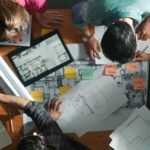Your Development Questions, Answered: Expert Insights You Need

When it comes to development, whether residential or commercial, questions are inevitable. The process of turning an idea into a successful project is complex, requiring careful planning, expert execution, and attention to countless details. At Triple-Play Consulting & Development, we welcome these questions because they allow us to build trust, provide clarity, and guide developers toward better decisions.
We’re tackling some of the most common and essential questions developers ask us. By providing clear answers and actionable insights, we aim to simplify the complexities of development and demonstrate how our expertise can guide you through every challenge with confidence.
1. How Do I Choose the Right Site for My Project?
Selecting the right site is essential for the success of any development. The process involves evaluating a range of factors, including zoning laws, accessibility, market demand, and environmental conditions.
Key considerations include:
- Transportation and amenities: Proximity to major roads, public transit, schools, shopping centers, or business hubs can influence the desirability of a site.
- Demographics: Population growth trends and local income levels help determine whether the area can support the proposed development.
- Zoning and land use: Understanding local regulations ensures the site is suitable for your intended purpose.
- Environmental factors: Soil stability, drainage, flood zones, and topography can impact construction feasibility and costs.
A thorough feasibility study can identify these factors and help you make informed decisions.
2. What Should I Know About Zoning and Land Use?
Zoning and land use regulations determine how a property can be developed and what activities are permitted. These rules vary significantly by location and can impact the size, use, and design of your project.
Tips for navigating zoning and land use:
- Research the specific zoning code for the property you’re considering.
- Understand restrictions such as height limits, density requirements, and setbacks.
- Determine whether rezoning or variances are needed, and plan for the time and cost involved in those processes.
- Engage with local planning boards early to understand their priorities and concerns.
Early attention to zoning ensures compliance and prevents costly delays.
3. How Do I Keep My Project On Time and Within Budget?
Delays and cost overruns are common challenges in development. To stay on track, you need a clear plan and consistent oversight.
Best practices include:
- Creating a detailed project timeline with milestones.
- Monitoring expenses regularly to identify and address budget variances early.
- Coordinating with contractors and vendors to avoid bottlenecks.
- Building contingency plans to account for unexpected delays or costs.
Effective project management is critical to balancing timelines, costs, and quality.
4. How Can I Maximize ROI on My Development?
Maximizing return on investment (ROI) requires strategic planning throughout the development process. Key factors influencing ROI include site selection, design efficiency, and long-term operational costs.
Ways to boost ROI:
- Choose a site in an area with growth potential, such as new infrastructure projects or population increases.
- Optimize layouts to maximize usable space while maintaining functionality.
- Incorporate energy-efficient and sustainable design to reduce operating costs.
- Conduct market research to position your development competitively.
Planning for both short-term profitability and long-term value ensures a strong ROI.
5. What Role Does Sustainability Play in Modern Development?
Sustainability has become a key consideration in development as stakeholders increasingly prioritize environmentally responsible practices. Sustainable design also reduces operating costs and enhances marketability.
Examples of sustainable practices include:
- Using renewable energy sources, such as solar panels or wind turbines.
- Designing buildings with energy-efficient HVAC systems and lighting.
- Incorporating green spaces to improve aesthetics and environmental impact.
- Obtaining certifications such as LEED to demonstrate sustainability commitment.
Sustainability isn’t just a trend—it’s a strategic advantage
6. How Do I Navigate Permitting and Regulatory Compliance?
Permits and regulatory approvals are mandatory but can be complex and time-consuming. Missing or incomplete documentation can delay your project.
Steps to simplify permitting:
- Research the permits required for your specific development.
- Create a checklist of necessary documents and deadlines.
- Build relationships with local agencies to streamline approvals.
- Stay up to date on building codes and regulations that may impact your project.
A proactive approach ensures your project meets all requirements while avoiding unnecessary setbacks.
7. How Important Is Design in the Development Process?
Design impacts not only the aesthetic appeal of your project but also its functionality, efficiency, and marketability. A well-thought-out design can attract buyers, tenants, and investors while reducing construction challenges.
Considerations for effective design:
- Focus on layouts that meet the needs of end users, whether residential or commercial.
- Balance visual appeal with practicality.
- Incorporate modern trends, such as open spaces, mixed-use elements, or energy-efficient features.
- Align design choices with the project’s goals and budget.
Good design is an investment that pays off in marketability and user satisfaction.
8. What Are the Biggest Risks I Should Be Aware Of?
Development involves risks, including financial uncertainties, environmental challenges, and construction delays. Identifying and mitigating these risks is essential.
Common risks to address:
- Environmental factors like soil conditions or flood zones.
- Fluctuations in construction material costs.
- Changes in market demand or competition.
- Delays in permitting or regulatory approvals.
A thorough risk assessment early in the project can minimize disruptions and ensure smoother execution.
9. How Do I Attract Investors or Tenants?
Securing funding or filling your development with tenants requires a compelling presentation and strategic marketing.
Strategies to attract interest:
- Highlight the project’s financial potential through clear data and projections.
- Create visually appealing presentations, including renderings and layouts.
- Leverage market research to demonstrate demand for your project.
- Build strong relationships with local brokers or leasing agents.
A clear value proposition makes your project stand out to stakeholders.
10. Why Is Choosing the Right Development Partner Important?
Selecting the right team ensures your project is executed efficiently and effectively. A strong development partner brings experience, resources, and solutions to overcome challenges.
Qualities to look for in a partner:
- Expertise in site selection, design, and construction management.
- Strong communication and transparency throughout the process.
- A track record of successful projects similar to your goals.
- A collaborative approach that prioritizes your vision and needs.
A great partner is your greatest asset in navigating the complexities of development.





